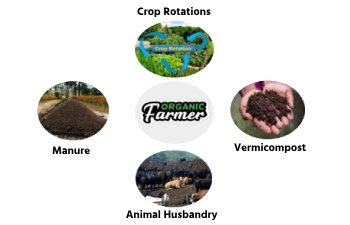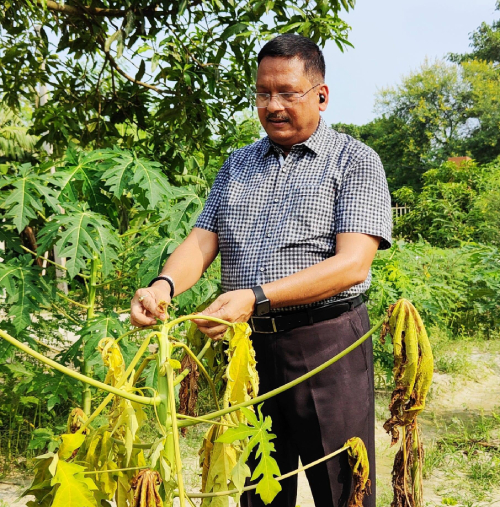.jpg)
Organic farming and Sustainable Agriculture
Raghvendra Kumar Kushwaha –( Research Scholar PG)
Guru Dayal - (Field Coordinator)*
M.Sc. (Agri.) Soil Science,
Sam Higginbottom University of Agriculture,
Technology and SciencesAllahabad-211007,U.P
Corresponding author Gmail- rkk18200@gmail.com
*Self-Reliant Initiatives Through Joint Action (SRIJAN),
Regional office, Mahavir Nagar,
Manikpur, Chitrakoot, U.P.
Gmail– gurudayal20195@gmail.com
Abstract
The world we are living in now is at a boundary of requirement of supplements that helps the human health to nourish better. Failing to fulfill this requirement will gradually result in declining our life span. This requirement can be fulfilled by the ingredients that we consume in our daily life via food. But this has been observed generally that the quality of the essential ingredients in the food is falling because of the procedure to obtain the food. The main reason so far discovered can be stated as the use of chemical and avoiding the organic way and harming nature. The only way to secure and maintaining the human health can be achieved by improving the quality of supplements we intake. The additional steps that should be considered during the achieving of goal of organic farming are that the resources should be managed too. As in, during the achieving of any goal the minute details are majorly left unattended which doesn’t results good. The step to look after the resources includes the sustainable management of natural resources which ensures the minimum and sufficient amount of resources to be used and also the amount required in further cases will be available. This write-up includes the way to achieve the goal to maintain the life i.e., aspects of organic farming as an integrated approach along with sustainable farming. Various methods, components, results etc. are discussed in here.
1. Introduction
The word “organic farming,” which dates back to 1900 EC, is very old. Sir Albert Howard, an English botanist Scientist (8 December 1873 to 20 cotober1947) received a thorough explanation of organic farming for the first time. He is credited as the father of organic farming in India. And Lord Northbourne (Walter James, 1896-19820) was the one who coined the term “organic farming.” He holds the title of “Father of organic farming” internationally. The first village in India to exclusively practice organic farming was Daspara in the state of Tripura. It is referred to as Indian’s first organic agricultural village and began with entirely organic farming. Additionally, Sikkim was designated as a fully organic farming state at the state level in 2003. Additionally, Estonia was officially recognized as the first organic farming nation in the world. Details regarding organic farming are provided in the 1940 book “Look to the Land” by Lord Northbourne. In his book, he has also discussed the idea of life as it relates to farming. Additionally, a movement for organic farming with the slogan “Give Back to Nature” was formed in the 1930. This term dates back thousands of years and is utilized to create massive chemical-free production. In addition, several actions were made to promote organic farming, including the following:
- The first issue of the magazine organic farming and Grading was published in 1942 by scientist JI Rodale.
- The only periodical with “organic farming” in the title was S. A. Howard’s 1947 publication The Soil and Health and A Study of Organic Agricultural.
- Switzerland’s Research Institute of organic Agriculture was founded there in 1973.
- The National Federation of Organic Farming in France (FNAB) was founded in 1978.
- In Versailles, France, The International Federation of Organic Agriculture Movements was founded in 1972.
2. Techniques or Methods of Organic Farming-
Organic farming is a type of farming technique that increases soil fertility and productivity as well as soil micro-organisms by utilizing organic fertilizer (such as vermicompost and bio-fertilizer) to produce crop in big quantities. Its main goal is to enhance the soil’s physical, chemical, and biological characteristics while also increasing crop output. These terms are used to define organic farming. To which this relates.
According to Codex definition (FAO)- “Organic Agriculture is a production management approach that fosters and improves the health of the agro-ecosystem, including biodiversity, the biological cycle, and biological activity. It emphasizes the use of management practices above the usage of off-farm inputs while taking into account the need for locally adopted methods to regional conditions.”(S.S. Rana,2011).
The main goal of organic farming is to produce an abundance of chemical-free food for the expanding population and to use organic fertilizer to boost soil fertility and productivity, preventing a decline in these factors and maintaining the soil’s high quality for human life. Managing chemical-free food is important since organic farming enables us to have a lot of wholesome foods. Organic farming employs a variety of method and procedures that make it simple to produce high-quality food and enhance the soil. Those being as follows:
A. Green Manure
B. Compost
C. Crop Rotation
D. Bio- fertilizer
E. Manure
F. Vermicompost
A. Green Manure- This particular form of organic fertilizer is made by mixing it in the field prior to the field’s blossoming period. By using it, the soil becomes more fertile and contains more nutrients. The following crops are grown for use as green manure.
| Crop | Scientific Name |
| Dhaincha | Sesbania aculeata |
| Sunhemp | Crotolaria juncea |
| Cluster bean | Cymopsis tetragonoloba |
| Pillipesara | Phaseolus trilobus |
Table 1- Crop and Scientific Name
B. Compost- It is a biological procedure that is dark brown in colour. Its use in the soil considerably increases the soil’s ability to move water. Compost must have a pH of 6.5 to 7.5 and between 15 to 25 % moisture content. Compost is utilized in general crop at a rate of 10 to 15 tonnes/ H. whereas vegetable crops use 20 to 25 tonnes/ H. Usually, there are two types.
i. Rural Compost- Crop waste, leaves of plant, Weed.
ii. Urban Compost- Night soil and other organic waste.
| Characteristic | Value |
| Colour | Dark brown to black |
| Bulk density (g/mg3) | 0.7-0.9 |
| EC (ds/m) | ≤ 4.0 |
| C:N Ratio | ≤ 20:1 |
| Total organic carbon | ≥ 16.0 |
Table 2 –Composition of well decomposed compost
C . Crop Rotation- Crop rotation is a form of technique used to eradicate pests and illness brought on by crops. Crop are rotated in the same field throughout the course of a year. For instance, crop with shallow roots and high water requirements may be planted in a field of crop with deep roots.
| Year of crop rotation | Crop Name |
| One year | Maize- Mustard Rice- Wheat |
| Two year | Maize- Mustard-Sugarcane-Fenugreek Maize- Potato- Sugarcane-Peas |
| Three year | Rice- Wheat- Mung-Mustard Cotton- Oat- Sugarcane- Peas- Maize-Wheat |
Table3- Different year and crop Rotations
D. Bio-Fertilizer- These organic fertilizer were created artificially. They are prepared using micro-organism. Its application enhances the field’s physical, chemical, and biological characteristics and stabilizes nitrogen. Here are a few examples of bio-fertilizer.
| Bio-fertilizer | Uses |
| Rhizobium | It is utilised in the production of pulse crops such peas, soybeans, chickpeas, alfalfa, and beans. |
| Azospirllum | The cereal crop pearl millet, finger millet, sorghum, and maize all utilise it. |
| Blue Green Algae (BGA) | In paddy fields, BGA is used. |
Table 4- Bio-fertilizer and uses
E. Manure- This kind of fertilizer is organic, and its name comes from the French word ‘MANOUVER.’ which means to “work with soil.” Its use in the field increases soil fertility productivity significantly and improves air circulation. It is mostly split into two sections.
i. Bulky organic manure- This manure is slow acting and contains a lot of organic materials. It is broken up into the following sections:
- Farmyard manure
- Compost
- Green manure
- Agro based industry wastes
- Human habitation waste
ii. Concentrated manure- It is split into two sections.
- Plant origin
- Animal origin
| Manure | Compositions |
| Farmyard manure | N- 0.5% P- 0.25% K- 0.5% C:N Ratio- 20-30:1 |
| Poultry | N- 1.46% P- 1.17% K- 0.62% |
| Vermicompost | N- 0.6 to 1.2 % P- 0.13to 0.22% K- 0.4 to 0.7% |
Table 5- Manure and its composition
F. Vermicompost- Vermicompost is an organic fertilizer that matures in two to three months. By employing it in the field, the soil’s air circulation and earthworm population both rise. Preparation should be done at a temperature of 25 to 30 degrees with a pH of 6.5 to 7.0. And it is thought that moisture between 50 to 60% is ideal for this. Throughout the Vermicomposting process.

Figure 1- Method and Techniques of Organic farming
3. Aim and objective of Organic farming-
It is a farming technique that increases productivity by employing organic fertilizer. Its major goal is to increase production at a lower cost, and the results are high-quality, extremely delectable products. Additionally, it improves the soil’s micro-organism’ fertility and production.
- It helps to keep the environment in balance.
- Keeps the land fertile for a long period.
- Produces high-quality food.
- Enhancing the soil’s physical, chemical, and biological properties.
- Disease, pest, and weed management.
- Increases the activity of soil micro-organism.
- Prevent pollution.
- The creation of wholesome food.
- Promote the usage of organic pesticides.
- Preserve biodiversity and safeguard animal welfare.
- Utilise the natural system.
- Increasing output while lowering costs.
- It enhances soil fertility by defending it against erosion and deterioration.
- Enhance soil aeration, water retention capacity, and water quality.
- Maintain the agricultural system’s genetic diversity.
4. Growth of organic farming-
It is a particular method of farming. Chemical fertilizer are utilised extensively in India as a result of the growing pollution, which has a significant negative impact on the soil’s fertility and productivity. The government has placed a lot of emphasis on organic farming in light of this. According to statistics for 2021-2022, organic farming is practices on 4393151.17 hectares (APEDA) of land in India, with Chhattisgarh, Madhya Pradesh, and Rajasthan making up the majority of this area. In addition, the APEDA report in India states that 3240349.01 MT of organic production was produced in 2020-2021 and that 2950920.79 MT of organic production will be produced in 2021-2022. The cultivated area (Organic + In-conversion) in India was 2657889.33 hectares in 2020-2021 and 4726714.74 hectares in 2021-2022 according to the APEDA data. The states with the greatest rates of organic farming are Madhya Pradesh, Rajasthan, and Maharashtra. India is one of the 187 countries that practice organic farming, and there are 2.30 million hectares of organic producers there, according to the FIBL Survey 2021. 30% of the world’s organic producers are located in India. In addition, the Indian government operates a number of programmers’ to support organic farming, which has revolutionised the industry. The many sorts of schemes are listed below.
1. Paramparagat Krishi Vikas Yojana (PKVY).
2. National Programme for Organic Production (NPOP)- by apeda
3. National Project on Organic Farming (NPOF) Scheme- NCOF
4. Mission Organic Value Chain Development for North Eastern Region (MOVCDNER).
5. National Project on Management of Soil Health and fertility.
6. Macro Management of Agriculture.
All of these programmers aid in the expansion and development of farmers group, Agril. Entrepreneur/Pvt. Agencies and individual farmer. (Source- Dr. A. Sailaja et.al. 2021)
| State | Organic Production | ||
| 2019-2020 (In Ha) |
2020-2021 |
2021-2022 (In MT) |
|
| Uttar Pradesh | 1,38,358.08 | 223.38 | 739.14 |
| Maharashtra | 9,04,786.75 | 38.57 | 30.37 |
| Madhya Pradesh | 9,45,506.03 | 9594.24 | 1,476.92 |
| Andhra Pradesh | 14,120.25 | - | 132.99 |
| Rajasthan | 1,68,751.00 | 4392.46 | 1,784.35 |
| West Bengal | 18,557.09 | 2.46 | - |
| Manipur | 16 | - | - |
| Jammu & Kashmir | 28,006.55 | 2437.40 | 3,064.02 |
| Bihar | 5.342 | - | - |
| Goa | 6,071.09 | 5345.39 | 3,594.27 |
| Chhattisgarh | 2,841.90 | 2513.38 | 3,152.75 |
| Kerala | 2.5 | 3.50 | 1.00 |
| Punjab | 1,026.15 | 980.49 | 428.67 |
| Odisha | 4,667.95 | 242.00 | 388.58 |
Table 6- Different state and organic production
Source: APEDA & Ministry of Commerce & Industry (2019-2022)





.jpg)
.jpg)
.jpg)
.jpg)